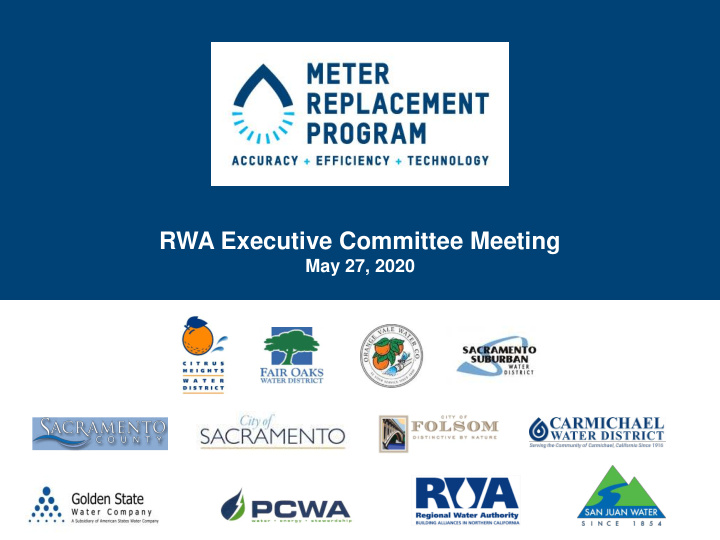



RWA Executive Committee Meeting May 27, 2020
Agenda 1. Introduction/Background • Consortium Formation • Project #1 – Planning/Integration Study 2. Study Overview 3. Next Steps • Study Findings & Recommendations • Consortium Agencies & RWA Policy Review 2
Introduction/Background Meter Consortium & Planning Study 3
Introduction/Background Why a Consortium for Meter Asset Management? 1. Economies of Scale • Planning • Purchasing • Capital Facilities & Equipment • Other On-going Operations & Maintenance Savings (Labor & Materials) 2. Building Collaborative Relationships in the Region • Sharing information (database with test data, failures, etc.) • Developing consistent meter testing protocols • Identifying other partnership opportunities “Sensible Integration” 4
Introduction/Background Consortium L1 L2 L3 “Sensible Integration” 5
Study Overview Project #1 – Planning/Integration Study 6
Study Overview Implementation Long-Term Planning/Implementation Strategy (4) Planning (5) Decisions Individual Next Generation Meter Testing Agency Program Options Program Information Assessments Analysis (2) Strategy (3) (1) 7
Study Overview 1. Individual Agency Assessment 2. Next Generation Program Options 3. Meter Testing Program Strategy 4. Implementation Strategy 5. Long Term Planning (Beyond Next Generation) 6. Final Report/Plan Adoption 7. Public Outreach Strategy We are here 8
Study Overview Deployed Meter Inventories Agency Average Age of Meters Number of 5/8” - 2” (Years) Meters Citrus Heights Water District 17 19,869 City of Folsom 7 21,386 City of Sacramento 12 129,086 Placer County Water Agency 10 37,078 Sacramento County 13 53,120 Sac Suburban Water District 11 42,225 San Juan Water District 19 10,558 TOTAL 313,322 9 9
Study Overview Deployed Meter Inventories 25,000 20,000 15,000 10,000 5,000 - 1996 1998 2000 2002 2004 2006 2008 2010 2012 2014 2016 2018 Consortium 10
Study Overview Opportunities to Collaborate Opportunity Type Key Opportunities Key Considerations Greater potential benefits Additional cost across the Consortium Potential for data vulnerability Information Sharing Better informed, more efficient Additional sources of potential agency decision-making error Inter-agency consistency Less control by individual Cost savings agencies Joint Purchasing Inter-agency consistency Negotiations more complex Larger potential recall risk Cost savings Negotiations more complex Joint Contracting Inter-agency consistency Less overall redundancy Services Easier to manage staff Less individual agency control workloads 11
Next Steps 12
Next Steps We are here AUGUST 2019 JUNE 2020 NOVEMBER 2019 JANUARY 2020 • Start of • • • Start of Start of Expected Start of Phase 4 & 5 Phase 1 Phase 2 Phase 3 Implementation Long-Term Planning Strategy (4) Planning (5) Decisions Individual Next Generation Meter Testing Agency Program Options Program Information Assessments Analysis (2) Strategy (3) (1) 13
Next Steps Implementation Plans Agency A – To Do List Policy Item Who By When Notes Program Item Who By When Notes Project/Task Item Who By When Notes 14
Next Steps Implementation Process Study Consortium RWA Executive RWA Board Concludes Approval Committee Findings & Review & Approval Policy-level Review Review & Approval Recommendations & Approval “Sensible Integration” 15
Next Steps Potential RWA Strategic Plan Objective Support programs that benefit from economies of scale in studies, planning, implementation, purchasing and resource sharing (e.g. Regional Aquifer Storage & Recovery (ASR), Meter Asset Management, Chemical Purchasing Program). “Sensible Integration” 16
Next Steps Consensus Direction Recommended • Recommend Strategic Plan language as provided in Slide 16 during the Zoom-based Strategic Planning Workshops on June 19 & 26, 2020 “Sensible Integration” 17
Discussion & Questions “Sensible Integration” 18
Recommend
More recommend